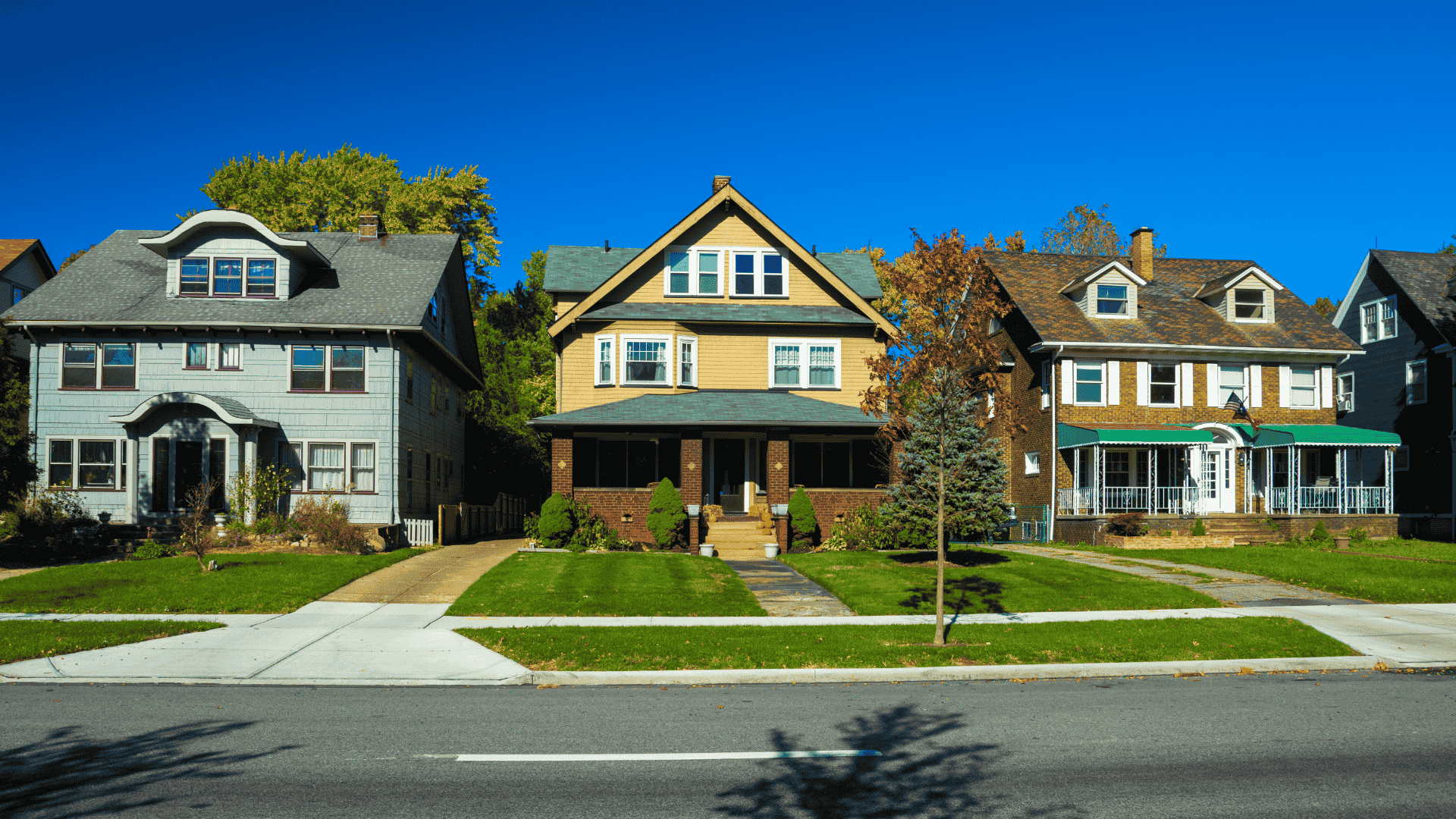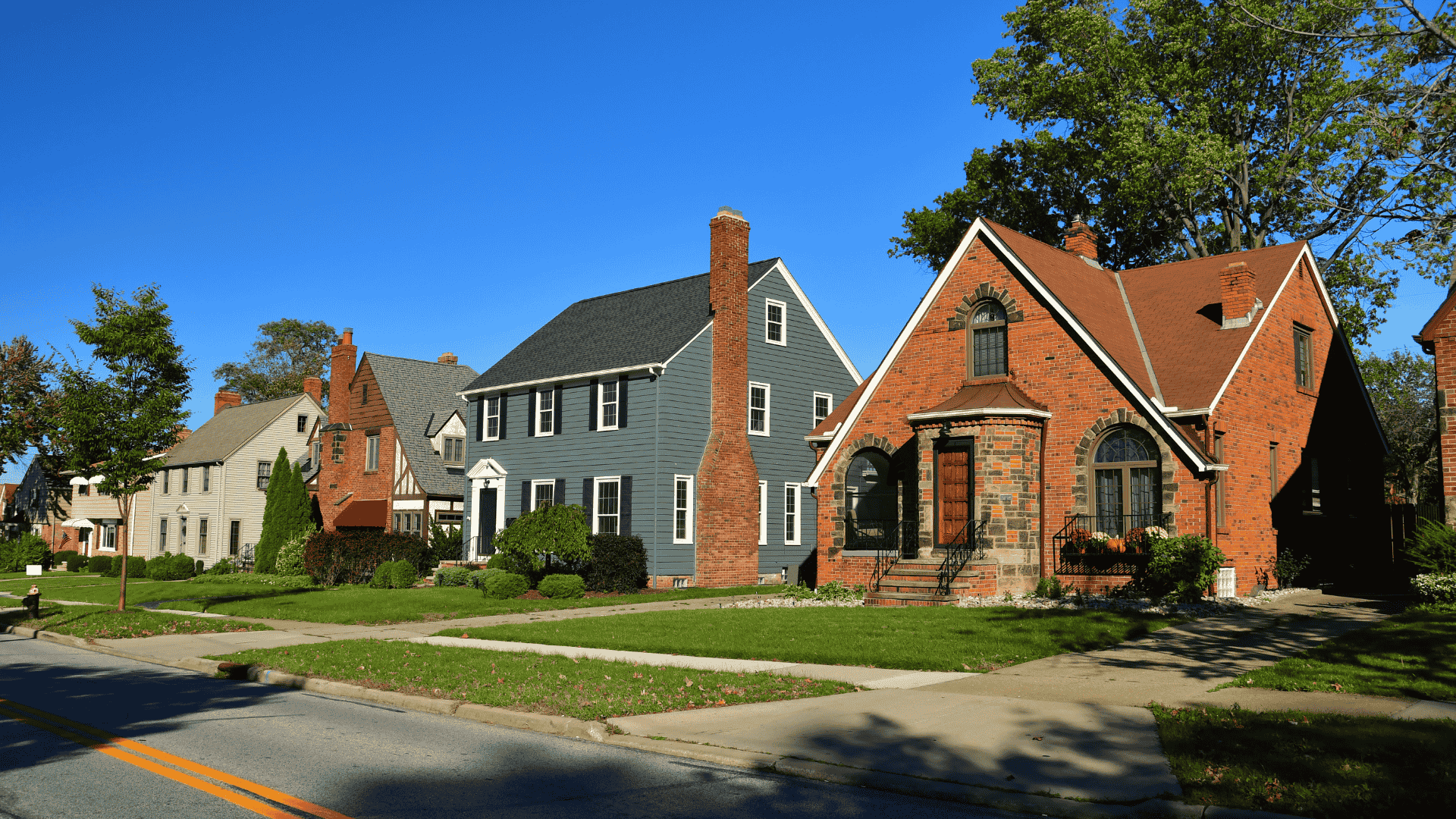Investing in Cleveland Real Estate: Everything You Need to Know
Cleveland: The Best Real Estate Market for Rental Property Investors in 2025
Updated: July 8th 2025
I’ve bought over 120+ rental properties across multiple U.S. real estate markets since 2016. One market that has always performed well for me is Cleveland. But while the city of Cleveland itself holds appeal, the best opportunities for rental property investments (in my experience) are to be found in the suburbs, often referred to as Greater Cleveland.
I’ve put together this analysis to provide you with an up-to-date (July 2025) look at (Greater) Cleveland’s real estate and rental markets. We’ll explore the data that support our long-term investment strategy. We’ll review some of the pros and cons of buying and owning rental properties here. You’ll also get some practical advice, and a list of specific neighbourhoods that stand out for building long-term wealth with rental property investments.
Before we get going, let’s just define exactly which areas we’re looking at: Greater Cleveland is a six-county region. It includes:
- Cuyahoga County (home to the City of Cleveland)
- Ashtabula County
- Geauga County
- Lake County
- Lorain County
- Medina County
It’s worth noting that the best rental property investment opportunities are found in Cuyahoga County. That’s where you’ll find a lot of decent C and B-Class neighbourhoods with well-priced properties and a more reliable tenant base. Those are the kind of deals that generate solid cashflow and grow in value over time. For clarity, I’ll refer to this entire area as just “Cleveland” and/or “Greater Cleveland” from hereon.
Investment Properties: Browse Turnkey Rental Properties in Cleveland in our Online Portal
Key Takeaways: Investing in Cleveland Real Estate
- Affordability: Cleveland offers significantly more affordable house prices compared to most U.S. markets. Local homebuyers can also afford to rent and buy without being ‘cost-burdened’.
- Cashflow Potential: Rent-to-price ratios in many neighbourhoods support potential for consistent positive cashflow from rental properties.
- Economic Stability: A diversified economy, anchored by healthcare and manufacturing, provides a resilient job market. The potential for reshoring of manufacturing in the U.S. offers future potential.
- Mixed Population Trends: After years of decline, the population of Cleveland is now growing. The existing population is also shifting, creating neighbourhood-specific opportunities.
- Older Housing Stock: Cleveland is home to some of the oldest housing in the U.S.. Home, sewer and roof inspections, and higher maintenance reserves are essential.
- Neighbourhood Variance: Some C and B-Class neighbourhoods offer promising rental investment opportunities. Others look good on paper, but come with inherent tenant issues.
Download Report: Download the Comprehensive Cleveland Real Estate Market Investor Report
Cleveland Real Estate Market Snapshot and Deep Dive
Understanding the current state of the real estate market is the first step for any real estate investor. Here’s a quick snapshot of the Greater Cleveland market as of July 2025:
- Population Trend: +0.9% p.a.
- Jobs Market: Concerning
- Unemployment Rate: 4.8%
- Home Values: $100,000 to $350,000 (for rentals)
- House Price Trend: +4.9% p.a.
- Housing Affordability: Good
- Inventory Levels: 3.9 months supply
- Rents: $995 to $1,850
- Renter Vacancy Rate: 5.8%
- Homeowner Vacancy Rate: 1.7%
First, let’s look at the basic demographic and socio-economic data that support profitable long-term rental property investments.
Population & Job Market Dynamics in Cleveland
The population and jobs market are primary drivers of housing demand. Let’s look at how the population of Cleveland is growing and changing as of 2025. We’ll also review the latest jobs market data for mid-2025.
Greater Cleveland Population Trends 2025

After decades of population decline, the population of Greater Cleveland is now growing. According the the latest Census data, Greater Cleveland has an estimated total population of approximately 2,184,627 residents, up 19,442 (+0.9%) since 2024.
Greater Cleveland Population Estimates June 2025
For the first time in decades, inward immigration has offset outward migration and natural birth/death attrition. This has resulted in net positive population growth in 2025.
The existing population is also shifting. As the City of Cleveland undergoes extensive redevelopment and gentrification, wealthy young professionals are moving into newly built downtown apartment units. This is driving a migration of low-to-mid-income families into the suburbs in search of more affordable housing and single family home living.
Pro Tip: Remember, real estate is local. Two adjacent neighbourhoods in Cleveland can be VERY different. Make sure you understand the demographic and socio-economic dynamics of the specific neighbourhood you’re buying rental property in.
Cleveland Jobs Market Snapshot 2025

If I have one concern about Cleveland, it’s the jobs market. Greater Cleveland boasts a diversified and generally stable economy with a total civilian workforce of 1,091,195 (May 2025).
The top sectors for employment in Cleveland are:
- Healthcare & Support: 12.5% of workforce.
- Office and Admin Support: 11.7% of workforce.
- Food Preparation and Serving: 8.6% of workforce.
- Transportation: 8.4% of workforce.
- Manufacturing: 8.2% of workforce.
- Sales: 8.1% of workforce
Source: Bureau of Labor and Statistics – June 2025
The biggest employment sectors in Cleveland is Healthcare and Healthcare Support (+29% higher than the U.S. national average). While not entirely “recession-proof,” the healthcare sector generally demonstrates resilience during economic downturns.
With huge employers such as the Cleveland Clinic and University Hospitals both expanding rapidly, it is possible that share of the jobs market could increase further. That might be a good thing for the long-term stability of the Cleveland jobs market.
Unemployment in Cleveland – Latest Data
Here’s where it gets more interesting. In May 2025, the unemployment rate in Greater Cleveland was 4.8% – up from 3.9% a year ago, and above the national average of 4.1%.
The total civilian workforce shrank by almost 6,000. meanwhile, the total number of unemployed increased by almost 10,000. This indicates a slowdown in hiring, which is unsurprising considering current economic uncertainty around tariffs and inflation.
Here’s a year-on-year snapshot of employment in Cleveland:
| Period | May 2024 | May 2025 | Change |
|---|---|---|---|
| Total Civilian Workforce | 1,096,878 | 1,091,195 | -5,638 |
| Total Unemployed | 42,565 | 52,185 | +9,620 |
| Unemployment Rate | 3.9% | 4.8% | +0.9% |
Source: Bureau of Labor and Statistics – June 2025
This is an area I’m keeping a close eye on. A softening jobs market could translate into a less reliable tenant base and weaker demand for housing. Hopefully hiring will pick up again through the second half of 2025 as the impact of Federal economic and trade policies become clearer.
Pro Tip: High quality tenant vetting is crucial. Vet your prospective tenants thoroughly. Look for solid employment history with reputable employers, and get references.
Greater Cleveland Real Estate Market July 2025
Now let’s take a deep dive into Cleveland’s real estate market.
Current Home Values & Trends in Cleveland (July 2025)

Home values in Cleveland have grown steadily since Q3 2012. Houses I bought in 2020 are appraising up to 50% higher in some cases. That said, Cleveland housing is still amongst the most affordable in the United States.
Here are some up to date numbers for each county, and the totals for Cleveland:
| County | Avg. Home Value | Median Sale to List Ratio | Day to Pending | Sales Over List Price | Sales Under List Price | Annual Price Growth |
|---|---|---|---|---|---|---|
| Cuyahoga | $214,474 | 99.7% | 7 | 38.3% | 47.9% | +5.0% |
| Ashtabula | $146,054 | 98.7% | 10 | 28.2% | 56.4% | +5.2% |
| Geauga | $373,498 | 99% | 7 | 34.8% | 56.7% | +4.6% |
| Lake | $241,266 | 99.4% | 7 | 29.9% | 51.7% | +4.6% |
| Lorain | $253,725 | 99.7% | 6 | 36.4% | 46.6% | +5.3% |
| Medina | $374,706 | 99.4% | 5 | 33.4% | 51.3% | +4.6% |
| Total Median | $247,496 | 99.4% | 7 | 34.1% | 51.5% | +4.8% |
Source: Zillow Ashtabula Zillow Cuyahoga Zillow Medina Zillow Lorain Zillow Lake Zillow Geauga Zillow Cleveland-Elyria MSA
According to these numbers from Zillow, homes typically go pending in around 7 days in Cleveland. They sell for 99.4% of list price on average, and 38% of homes sell over list price. That’s a pretty healthy market!
With that said, my personal experience tells me that well-priced homes tend to go under contract between 30 and 45 days. Of course, that all depends on the property, location, condition, pricing, and your real estate agent.
Future Outlook for Cleveland House Prices
Analysts are forecasting stable houses prices in Cleveland through 2025. A return to more sustainable growth of 5% p.a. is expected going into 2026. Of course, there are lots of variables to consider. A significant drop in mortgage rates would likely see more buyers, and house prices rising faster. A sharp increase in inventory would likely see house prices stall, or even fall slightly.
Housing Affordability

For me, housing affordability is a really important metric. If locals can’t afford to rent or buy a home, that’s a sign the market is overpriced. It might also mean tenants struggle to pay their rent. That means higher property management costs, evictions, vacancies, and turnover costs. All the things we want to try and avoid as rental property investors.
Measuring Housing Affordability
The widely accepted standard for measuring housing affordability is the 30% rule. People spending more than 30% of their income on housing costs are considered “cost-burdened“. For context, the current national averages are 36% for homeowners, and 32% for renters.
Housing Affordability in Greater Cleveland
According to a recent analysis by U.S. News, Cleveland is the second most affordable place to buy a home in America. Homeowners spend just 19.1% of their income on their mortgage payment. When you add in property taxes, utilities and insurance, that number jumps to 27%. The Regional Price Parities Index also puts housing costs in Cleveland at around 20.5% cheaper than the national average.
For renters (and rental property investors) in Cleveland, it’s even better! For example, the estimated average household income in Cuyahoga County in 2025 is around $69,292 ($5,771 per month). The average rent is $1,459. That gives us an affordability ratio for renters of 25.3% – one of the best in the United States!
Here’s my own analysis of current housing affordability in Cleveland split by County:
| Area | Household Income* | Avg. Rent | Affordability Ratio |
|---|---|---|---|
| Cuyahoga County | $62,292 | $1,459 | 25.3% |
| Lorain County | $83,195 | $1,386 | 19.9% |
| Geauga County | $112,840 | $1,917 | 20.4% |
| Medina County | $102,157 | $1,861 | 21.9% |
| Lake County | $85,995 | $1,535 | 21.4% |
| Ashtabula County | $61,196 | N/A | N/A |
| Greater Cleveland | $73,295 | $1,479 | 23.9% |
*Latest available data from 2023 U.S. Census adjusted for 2025 at +5% p.a.
Source: Zillow Ashtabula U.S. Census Astabula Zillow Cuyahoga U.S. Census Cuyahoga Zillow Medina U.S. Census Medina Zillow Lorain U.S. Census Lorain Zillow Lake U.S. Census Lake Zillow Geauga U.S. Census Geauga
The data – along with my personal experience – suggests that Cleveland is still a very affordable housing market. Renters and homebuyers are not cost-burdened. That makes Cleveland one of the most attractive and resilient real estate markets in the U.S. for rental property investors focussed on consistent and reliable cashflow.
Pro Tip: A good rule of thumb when vetting tenants is to ensure their total monthly income is at least 3 times the rent amount. This is a good standard to ensure your tenants won’t struggle to make rent payments on time.
Housing Inventory in Cleveland

The number of homes for sale is a good indicator of whether a market favours buyers or sellers. The trend can also indicate whether a market is heating or cooling. Generally speaking, analysts use ‘months of supply’ as a key indicator:
- < 6 Months Housing Supply: Sellers market
- ~ 6 Months Housing Supply: Balanced market
- > 6 Months Housing Supply: Buyers market
Housing inventory in Cleveland is tight. There are not enough homes hitting the market to meet demand. This is one of the reasons Cleveland is showing exceptional resilience right now in 2025 when other regional markets are seeing house prices fall.
As of May 31st 2025 Cuyahoga County had 4,689 homes for sale and 1,206 homes sold. That gives us:
- 3.9 Months Housing Supply: Sellers market
Based on current levels of home sales, Cuyahoga County would need around 7,236 homes for sale to be considered a balanced market. That’s a total increase of 2,547 homes for sale. At the current rate of sales vs new listings, that would take around 5 months all things being equal. Source: Realtor.com Akron Cleveland Association of Realtors
One thing to note is that while housing inventory in Cleveland is still very tight’, it is rising. More homes are hitting the market, and inventory in Cuyahoga County is up 37% year-on-year. That could indicate the market is starting to cool. That’s no bad thing in my opinion.
Cleveland Area Rental Market Analysis

A strong rental market is the backbone of successful rental property investment. Cleveland is one of my favourites – and best performers. As investors, a good starting point for assessing the viability of a rental market to the rent-to-price ratio.
Average Rents & Rent-to-Price Ratio
One thing to bear in mind with Cleveland is that house prices and rents vary wildly from one neighbourhood to another. Cheaper properties on the East side can have a rent to price ratio greater than 1%. But those neighbourhoods are often run down, and the tenant base can be unreliable and problematic.
Likewise, a fully-renovated 3-bedroom turnkey rental property in Old Brooklyn will rent for between $1,500 to $1,850. For context, I just renewed a lease for a very nice 3 bedroom 2 bathroom property in the Old Brooklyn Neighbourhood for $1,750 per month. I purchased that fully-renovated house in 2024 for $175,000.
Here are the median market rents according to HUD. These are 50th percentile rents. So out of 100 properties, 50 will be more expensive, and 49 will be cheaper:
| County | Studio | 1 Bedroom | 2 Bedroom | 3 Bedroom | 4 Bedroom |
|---|---|---|---|---|---|
| Cuyahoga County | $936 | $1,058 | $1,284 | $1,651 | $1,772 |
| Geauga County | $936 | $1,058 | $1,284 | $1,651 | $1,772 |
| Lake County | $936 | $1,058 | $1,284 | $1,651 | $1,772 |
| Lorain County | $936 | $1,058 | $1,284 | $1,651 | $1,772 |
| Medina County | $936 | $1,058 | $1,284 | $1,651 | $1,772 |
Source: HUD User Median Market Rents 2025
Rental Demand & Vacancy Rates in Cleveland
Cleveland has always has a strong rental market. The homeownership rate is about 60%, so there are lots of renters and a shortage of good quality homes for them to live in:
- Large Student Population: Universities like Case Western Reserve University, Cleveland State University, and others in the metro area create a steady demand for student housing.
- Workforce Mobility: The region’s diversified job market, especially in healthcare and tech, attracts a transient workforce who often prefer to rent.
- Affordability for Renters: Even with rising rents, the cost of renting in Greater Cleveland remains more affordable than in many larger U.S. cities, keeping demand strong.
While Cleveland-specific vacancy rate data are not readily available, there are some useful metrics we can refer to. Both homeowner and rental vacancy rates in Ohio are noted as being at or near their lowest levels on record.
The rental vacancy rate for Ohio was 5.8% in 2024. This is an annual figure, updated as of March 18, 2025. While this is a statewide figure, it provides a good general indication.
Anecdotally speaking, our property manager in Cleveland who manages 1,000+ units has a total vacancy rate of around 5% to 10%. Well-appointed and fairly-priced rentals tend to receive multiple applications within days of listing.
Pro Tip: When underwriting your rental property investment in Cleveland, plan for a vacancy rate of between 5% and 10%.
Pros and Cons of Investing in Cleveland Rental Properties

Like any market, Cleveland offers a unique set of opportunities and challenges for real estate investors.
Advantages for Investors (Pros)
- High Affordability: This is arguably Cleveland’s biggest draw. A lower barrier to entry gives us the potential to acquire multiple properties.
- Strong Cash Flow Potential: The combination of affordable house prices and solid rental demand translates into attractive rent-to-price ratios and consistent cash flow.
- Diversified & Stable Economy: The presence of major healthcare, education, and manufacturing sectors provides economic resilience. This stability helps protect property values and rental income even during broader economic shifts.
- Landlord-Friendly State: Ohio’s legal framework generally provides a more favourable environment for landlords compared to some other states. This simplifies property management – especially dealing with problem tenants.
- Price Appreciation: House prices in Cleveland are likely to continue to grow steadily over the next few years. With average prices well below the national average, and housing affordability still strong, the potential for future appreciation is excellent.
Potential Challenges & Risks (Cons)
- Older Housing Stock: A significant portion of properties in Greater Cleveland are older. This can lead to higher maintenance, repair, and capital expenditure costs (e.g., roofs, HVAC, plumbing, electrical updates).
- Property Taxes: While home prices are lower, property tax rates in some neighbourhoods can be relatively high. This impacts your net cash flow and should be factored into your underwriting.
- Neighbourhood Variation: There’s a wide disparity in property conditions, crime rates, and tenant quality across different neighbourhoods. Thorough, hyper-local research is essential to avoid problematic areas.
- Competition for Good Deals: As Cleveland gains recognition as a leading rental property investment market, competition for well-priced, cash-flowing properties is increasing.
Pro Tip: Work with local partners (agents, inspectors, property managers, appraisers etc.) that know the area, and are experienced in working with investors.
Top Neighbourhoods for Rental Property Investment in Cleveland

I cannot stress this enough… Choosing the right neighbourhood in Cleveland is critical for rental property investing success. I’ve mentioned this already. Some neighbourhoods look great on paper. Cheap house prices. High rents. Guaranteed rents from Section 8. It all looks great. In my experience, those deals NEVER turn out how you think they will.
If you’re chasing ‘cheap’ and ‘high cashflow’, expect problems. bad tenants, social issues, property damage, higher property management costs, low/zero appreciation, and more turnovers. In my experience, paying more for a better location pays dividends. Slow and steady wins the race!
Here are a few of my favourite Cleveland neighbourhoods with great potential for rentals:
1. Old Brooklyn (Cleveland, Cuyahoga County)
- Overview & Demographics: Located on Cleveland’s southwest side, Old Brooklyn is a large, family-friendly neighbourhood with a mix of housing styles and a strong community feel. It’s one of Cleveland’s most populous neighbourhoods.
- Investment Appeal: Offers affordable single-family homes and small multifamily. It attracts working-class families seeking stable, community-oriented living. Good access to I-71 and downtown Cleveland.
- Rental Performance: Generally provides solid cash flow due to reasonable property prices and consistent demand from long-term renters. As always, through tenant vetting and high quality property management is advised.
2. Clark-Fulton (Cleveland, Cuyahoga County)
- Overview & Demographics: Situated on Cleveland’s near west side, Clark-Fulton is a vibrant, diverse neighbourhood undergoing significant revitalization. It’s home to MetroHealth Medical Center, a major employer.
- Investment Appeal: Offers strong growth potential due to ongoing development and its proximity to a major healthcare institution. Properties are still relatively affordable, attracting a mix of workforce tenants.
- Rental Performance: Rents are stable, vacancy rates are low, and the area’s revitalization could lead to long-term price appreciation.
3. Puritas-Longmead (Cleveland, Cuyahoga County)
- Overview & Demographics: Located on Cleveland’s west side, closer to Cleveland Hopkins International Airport. It’s primarily a residential neighbourhood with good transportation access.
- Investment Appeal: Known for its stability and relatively accessible property prices. Its proximity to the airport and major highways makes it attractive to commuter tenants.
- Rental Performance: Offers consistent rental demand and reliable cash flow for investors seeking stable, less speculative opportunities.
4. Lakewood (Cuyahoga County)
- Overview & Demographics: Just west of downtown Cleveland, Lakewood is a densely populated, highly walkable city known for its historic homes, vibrant downtown, and proximity to Lake Erie. It attracts young professionals and families.
- Investment Appeal: While properties are generally more expensive than in the city of Cleveland, Lakewood boasts strong rental demand and higher average rents. Its desirability often leads to lower vacancy rates.
- Rental Performance: Offers strong rental income and potential for long-term appreciation due to its desirability and amenities.
Investment Properties: Browse Turnkey Rental Properties for Sale in Cleveland in our Online Portal
Practical Advice & Tips for Investing in Cleveland
Successful rental property investment requires careful planning and execution. Here’s practical advice for real estate investors targeting Greater Cleveland:
Due Diligence Essentials
- Thorough Property Inspection: Given the older housing stock, a comprehensive inspection is non-negotiable. Pay close attention to the roof, foundation, electrical, plumbing, and HVAC systems.
- Sewer Scope: Always get a sewer line inspection. Older homes can have costly sewer issues.
- Neighbourhood Assessment: Do not rely solely on online data. If you cannot visit in person, use tools like Google Street View, research local crime statistics, and talk to local property managers to understand the specific block-by-block dynamics.
- Financial Preparedness: Ensure you have your financing in order. Consider specialized loans like DSCR Loans. Have your down payment and reserves ready.
Property Management & Tenant Vetting
- Hire a Quality Local Property Manager: This is crucial, especially for out-of-state or international investors. A good manager understands local laws, market rents, and tenant Base. They can handle maintenance and tenant issues efficiently.
- Rigorous Tenant Screening: Due to varying income levels across the metro area, strict tenant screening (credit checks, background checks, income verification, rental history) is vital to secure reliable tenants and protect your consistent cash flow.
Understanding Local Market Nuances
- Be Ready to Act: Good deals, especially those offering strong cash flow, can go quickly in a competitive market. Have your team (agent, lender, property manager) in place to move fast.
- Assess Infrastructure: Be aware that some areas may have older infrastructure (roads, utilities). Factor potential impacts into your long-term planning.
- Lead Paint Disclosures: For homes built before 1978, lead paint disclosures are required. Understand the implications and your responsibilities as a landlord.
Investment Properties: Browse Turnkey Rental Properties for Sale in Cleveland in our Online Portal
Expert Outlook on the Cleveland Rental Property Market
Industry experts generally maintain a positive, albeit realistic, outlook for the Cleveland real estate market, particularly for rental properties. The consensus points to continued stability and growth.
- Sustainable Growth: Unlike some boom-and-bust markets, Cleveland’s growth is often seen as more sustainable due to its affordability and economic diversification. I plan for 5% p.a. price growth in my underwriting, and that’s turned out to be quite conservative.
- Investor Appeal: Experts continue to highlight Cleveland as a market with strong cash flow opportunities, especially for investors willing to manage older properties or invest in revitalizing areas.
- Resilience: The strong presence of anchor institutions like the Cleveland Clinic provides a significant buffer against economic downturns, contributing to market resilience.
For real estate investors, Greater Cleveland is a compelling option for building long-term wealth through consistent cash flow from rental properties. Its affordability and stable economic base make it a strategic choice in the current landscape.
If you’d like to talk about investing in rental properties in Cleveland, my door is always open. You can schedule a call with me or a member of my team and we’ll be happy to assist.
GROW YOUR WEALTH WITH U.S. REAL ESTATE
Start your U.S. real estate investment journey today with high-quality cashflow real estate. Book a Free 1-2-1 Discovery Call with a member of our senior management team to discuss your personalized strategy.
“Having personally invested in over 120 US rental properties from overseas, I know the true value of getting the right advice and support.
David Garner – Cashflow Rentals
GROW YOUR WEALTH WITH U.S. REAL ESTATE
Start your US real estate investment journey today, and book a Free 1-2-1 Discovery Call with a member of our senior management team.
“Having personally invested in over 120 US rental properties from overseas, I know the true value of getting the right advice and support.
David Garner – Cashflow Rentals

Frequently Asked Questions about Investing in Cleveland Real Estate
- What are the best neighborhoods to invest in Cleveland for rental properties?
- For rental property investments in Cleveland, top neighborhoods known for their potential include Old Brooklyn, Clark-Fulton, Puritas-Longmead, and Lakewood. These areas, primarily in Cuyahoga County, offer a mix of affordability, strong rental demand, and community stability.
- What specific challenges should investors anticipate when dealing with Cleveland’s older housing stock?
- Given Cleveland’s older housing inventory, investors should prepare for potentially higher maintenance, repair, and capital expenditure costs for components like roofs, foundations, electrical systems, plumbing, and HVAC. A comprehensive property inspection and sewer line inspection are essential to identify potential issues beforehand.
- Are there any specific local city regulations or certifications (e.g., lead-safe, local agent-in-charge) that Cleveland landlords must be aware of?
- Yes, landlords in the City of Cleveland must comply with specific regulations such as obtaining a Certificate of Rental Occupancy, adhering to the Lead Safe ordinance (requiring a 2-year or 20-year certification for rental units built before 1978), and ensuring no open code violations. For property owners residing outside Cuyahoga or a contiguous county, the appointment of a local agent-in-charge who lives in the area may also be required.
- How do property tax rates in different Greater Cleveland counties impact rental property cash flow?
- While Cleveland offers affordable home prices, property tax rates can vary significantly by neighborhood and county within Greater Cleveland. Investors must factor these specific tax rates into their investment analysis, as they directly influence net cash flow. Thorough due diligence on property taxes for the target location is crucial.
- Beyond cash flow, what are the long-term appreciation prospects for Cleveland rental properties?
- Analysts forecast stable house prices in Cleveland through 2025, with a return to sustainable growth of around 5% per annum expected into 2026. With average prices below the national average and strong housing affordability, the market offers excellent potential for steady, long-term appreciation, especially compared to more volatile markets.
- What financing options are typically available for out-of-state or international investors in Cleveland?
- Out-of-state investors commonly utilize conventional loans for investment properties. For international investors or those seeking specific terms, specialized financing options like Debt Service Coverage Ratio (DSCR) loans or Foreign National Loans are often available, which cater to non-resident borrowers.
- What are the key differences between investing in single-family homes versus multi-family units in Cleveland?
- Cleveland offers opportunities for both single-family homes and small multi-family properties (like duplexes). Single-family homes in B and C-Class neighborhoods are often favored for stable cash flow and reliable tenant bases, particularly appealing to families seeking affordable housing in the suburbs. Multi-family units can offer economies of scale in management and potentially higher overall rental income from a single property, but may come with different tenant dynamics and property management complexities.
- How does Cleveland’s job market stability affect rental property demand?
- Greater Cleveland’s diversified and generally stable economy, particularly its strong healthcare sector, contributes to consistent rental demand. While there was a recent slight increase in unemployment, the presence of major employers like Cleveland Clinic helps maintain a resilient job market, supporting a reliable tenant base for rental properties.
- What is the average rent and typical rent-to-price ratio for investment properties in Cleveland?
- Average rents in Cleveland vary by county and property type. For example, the average rent in Cuyahoga County is around $1,459. Rent-to-price ratios in many neighborhoods can be favorable, with well-priced 3-bedroom properties, for instance, often achieving ratios that support solid positive cash flow.
- How important is professional property management for out-of-state investors in Cleveland?
- Hiring a quality local property manager is crucial for out-of-state and international investors. A good manager understands local laws, market rents, handles maintenance and tenant issues efficiently, and can provide rigorous tenant screening, which is vital for securing reliable tenants and protecting cash flow in Cleveland’s varied neighborhoods.







![USA Property Investment for Foreign Buyers [2025 Guide]](https://cashflowrentals.net/wp-content/uploads/2025/07/USA-Property-Investment-for-Foreigners-Expert-2025-Guide-500x383.png)



